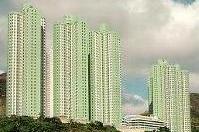
 |
Housing Conference 1996Mr FUNG Tung, OBE, JPCountry PresentationHong Kong 21 May 1996 |
I wish to focus my talk on the public housing field in Hong Kong. I shall start by giving a brief description of the inception of the public housing programme, an overview of the current housing scene, and share with you some of my thoughts on the challenges ahead.
Development of Public Housing in Hong Kong
2. At the end of the Pacific War, there was severe shortage of housing in Hong Kong as a result of the return of original residents and influx of immigrants. Many of them resorted to illegal squatting all over the territory. By 1949 the squatter population was estimated to be around 300,000, comprising 15% of the total population of Hong Kong.
3. On Christmas Day 1953, a fire swept through the Shek Kip Mei squatter area, leaving 53,000 people homeless. The Government had to find a quick solution to offer these homeless families a roof over their heads. As a result, the Resettlement Department was established and the first resettlement blocks were constructed. The amount of living space allocated at that earliest stage of our public housing development was approximately 2.2 sq. m. per adult. The resettlement programme was later extended to cater for the rehousing need of people affected by the Government's clearance operations.
4. In the meantime, a number of voluntary housing organisations, such as the Housing Society and the former Housing Authority, were established to provide low cost rental housing to cater for that segment of the public which because of their low income could not afford satisfactory homes in the private sector. The Housing Society and the former Housing Authority were very valuable in that not only were they able to offer low cost rental housing to a very large number of families, but also because of the importance they placed on planning, administration and management, providing for the tenants concerned a standard of living which they would not otherwise be able to enjoy.
5. Thus in the 1950's and 1960's, there set side by side in Hong Kong two main streams of public housing: a resettlement programme conducted and run by Government itself and which unfortunately bore the usual undesirable stigma and effects of social housing for the low income groups; on the other hand, there were the rather well-run housing estates provided by the Housing Society and the former Housing Authority. This was an interesting period for housing scholars who were interested in comparing the results and effects of different concepts of public housing provision.
6. In 1973, a new Housing Authority was formed. The new Housing Authority started an era whereby Government's various functions in public housing were placed under the umbrella of one big organisation. At the same time, the Housing Department was also established as the executive arm of the Housing Authority through which the Authority plans, designs, builds and manages public sector housing.
7. In 1988, the Housing Authority was reorganised and a non-official chairman was instituted, with the Authority given greater financial and development autonomy. Six years later, a new Housing Branch under the Government was established to take over responsibility for developing strategies for the provision of public as well as private housing in Hong Kong.
The Hong Kong Housing Authority8. To date, the Hong Kong Housing Authority has about 660,000 public rental flats in 160 estates and over 200,000 home ownership flats in 131 courts,
providing accommodation for half of Hong Kong's population. The Authority also manages some one million sq. m. of commercial space in the estates. Our tenants, on average, enjoy 8 sq. m of living space per person. The Housing Authority prides itself by building communities, and not just domicile towns. Within each public rental estate, we have included in commercial centres, schools, welfare premises, recreational open spaces, and landscaped gardens. Other than places of work, therefore, our tenants' daily necessities are well catered for within the confines of the estates.
Finances9. The Authority is a financially autonomous body responsible for managing its own finances. Under the financial arrangements between the Government and the Authority, the Government is committed to subsidizing the Authority's massive public housing programme with the provision of free land for public rental housing and sites for flats for sale at concessionary prices.
10. The Authority has a vast finance portfolio: our annual turnover, i.e. income and expenditure combined, exceeds $59 billion. Our major sources of income are revenues from the sale of home ownership flats and rents collected from the public rental flats. The Authority maintains prudent financial policies to ensure that we can make the best use of our funds. Since 1992, we have been able to meet not only our recurrent expense but also capital expenditure.
11. The cash balance of the Authority currently stands at about $26 billion. The money will be ploughed back in the massive public housing programme to ensure that our tenants would be the ultimate beneficiaries.
Rent Policy12. A successful public housing programme brings social stability. To achieve its social objective, public housing must be offered at rents that are affordable to our tenants. We must, however, also ensure that the rents are realistic and sustainable from the point of view of the Housing Authority's finance. We believe we have struck a balance by setting a rent policy that aims at charging rents at a median-rent-to-income ratio of not exceeding 15%.
13. The Authority has a wide range of flat types and rent levels to cater for tenants with different levels of income. On average, our tenants are paying a monthly rental of 8.7% of their income, compared with 26% in the private sector.
14. As an indicator that our rents are affordable, our rent default rate has been extremely low. For the past two years, the default rates were typically 2% of the total domestic rent receivable. In most cases, the rent was eventually paid.
Home Ownership
15. It is the Hong Kong Government and Housing Authority policy to encourage home-ownership among those who can afford it. Since 1978, we have built more than 200,000 flats for sale. Our target groups include tenants whose standard of living has improved; and those who are renting in the private sector but cannot afford to buy a private sector flat.
16. The main criterion to determine the prices of these home ownership flats is affordability.
To ensure affordability, we have been selling flats at a discount of between 45% and 48% of market prices in the last two years,and the over-subscription rates have exceeded between 10 and 16 times the number of flats offered for sale in the respective exercises. The home ownership rate in the public sector is now 25%, starting from nil in 1978.
New Construction17. With a building target of an annual average of forty thousand flats for the past few years,
the Housing Authority is probably one of the largest developers of social housing in the world. We are constantly working to encourage efficient and reliable construction methods without compromising quality.
18. To enable us to exercise control over contractor's performance, we have our own List of Building Contractors and have put in place a comprehensive set of Rules of Administration of the List. Since April 1993, all new works building contractors tendering for the Authority's projects are required to be certified to the international quality assured standard ISO 9000.
19. To improve building efficiency, the Authority has adopted the use of standardized building designs for more than twenty years. The concept of standardization has been further developed through the use of systems of large panel casting of insitu concrete, and more recently, the use of factory produced components as well as precast concrete building elements. The evolution has culminated in a number of innovative building techniques adopted in the Harmony series, the current major standard block design and the new Home Ownership Scheme Concord series which will come on stream in 1999.
Housing Maintenance
20. With part of our housing stock approaching forty years of age, the Authority places great emphasis on maintenance of its housing stock. We have implemented a programme of Structural Appraisal, Strengthening and Monitoring to ensure the structural integrity of our housing stock. In parallel, general building and building maintenance is implemented under what we call a CARE ( Condition, Appraisal, Repair and Examination ) programme. Under the CARE programme, all rental blocks not in the redevelopment programme are subject to a comprehensive building conditions survey at a six-yearly interval. Since its introduction in 1993, over eighty public housing estates have been put onto the CARE cycle and all housing estates will be covered by 1997.
Tenants' Participation in Management
21. In a rapidly politicizing community, the Authority fully appreciates the importance of setting up a decentralized housing management structure with strong tenants' participation. In most public rental estates residents' organisations are elected by the tenants. These organisations are encouraged to take an active role in the day-to-day management of their respective housing blocks. Since 1994, we have launched a pilot Estate Management Advisory Committee ( EMAC ) Scheme in selected estates. The membership of each committee comprises the estate Housing Manager and representatives of residents' organizations. The main role of these committees is to advise the Housing Manager on priorities on expenditure on maintenance and improvements within the estate. In view of the favourable response received since its implementation, we now plan to extend the EMAC Scheme to all Housing Authority rental estates in the next two years.
Housing Challenge Ahead22. I hope I have been successful so far in impressing on you that we have been able to put the scene together on a number of important issues. But we can by no means be complacent yet. Building, managing and maintaining homes for nearly three million people is no easy task. There are many challenges ahead as our housing programme rolls forward. These I shall attempt to highlight in the remaining parts of my presentation.
Rising Demand and Shortfall in Housing Production23. The Authority's current policies and programmes are set within the framework of the Long Term Housing Strategy ( LTHS ) promulgated in 1987. The underlying objectives of the Strategy are to achieve an efficient and equitable use of resources by ensuring that a household's housing benefit is in relation to its needs; to provide adequate housing at an affordable price or rent to all households; to promote home ownership and social mobility among sitting tenants; and to redevelop older public housing estates. Under the broad LTHS assessment, the public sector is to produce, on average, 40,000 flats a year and the private 30,000 flats a year up to 2001. The production targets are adjusted on an annual basis to reflect changes in demand, supply and other parameters as regards priority in allocation.
24. As a result of the demographic changes and the play of both internal and external economic factors, local housing demand has increased significantly over the past few years. Subsequent to a recent reassessment, the estimated demand for public and private housing has been brought up to over 600,000 between now and the turn of the century. To catch up with the increased demand, the public sector will need to produce, on average, 57,000 flats a year in the next five years.
25. In order to be able to increase production with demand, the Authority has to be very flexible in the deployment of resources: manpower, finance, and most important of all, land. In this context, the Authority is much encouraged by the positive move the Government made in recent years in allocating land for public housing development. However, we must be very cautious that owing to our topographic constraints and other limitations, land development in Hong Kong entails a series of complex and time-consuming procedures involving land resumption, clearance, provision of infrastruture and site formation, which may take several years to complete. Complications encountered in any of these procedures would result in the land not being able to be made ready in time for building of flats, thus resulting slippage of production beyond the LTHS period. In fact, owing to the uneven availability of land in the late 80's and early 90's, we are faced with a downturn in production from now to 1999. On the other hand, as a direct result of this, there are clear signs of a "bunching" of production of over 80,000 flats a year from 1999 to 2001. One could well appreciate what an extremely tight production schedule we are working on to meet our LTHS commitments.
26. As a stop-gap measure to address the imminent shortfall in production, the Authority is exploring various alternatives such as increasing the height of standard domestic blocks and adopting a more flexible arrangement for open spaces etc. to optimize the use of land. We will also continue to pursue with the Government on increase of land supply and work closely with the other concerned departments to resolve any critical issues that may stand in the way of housing production. I hope, through all these efforts, we will be able to complete our production programme within the set timeframe.
Low Mobility of Rental Tenants27. In 1987, there were 180,000 applicants on the Authority's waiting list for public rental housing. The then LTHS target was that the waiting list could be substantially cleared by 1997. In spite of the production of over 210,000 new rental flats by the Authority since 1987, the waiting list still stands at 150,000 as at present, with the average waiting time being seven years. Every month, we are receiving 2,000 more applications. For the non-owner-occupier households in the private sector with income below the waiting list income limit, their rent-to-income ratio is very high, at 33%. In general, they occupy a small space of not more than 6 sq. m. per person. The issue at stake is crystal clear: notwithstanding our notable attainments over the past years, there are a large number of less fortunate households in the private sector who have pressing housing needs.
28. As stated earlier, one of the main objectives of our LTHS is to achieve efficient and equitable use of resources by ensuring that a household's benefit from housing subsidy is in relation to its need. A subsidy to the poor may be justified, but we cannot leave it as a perpetual right when family circumstances have changed and the continuous need for public housing no longer exists. Accordingly, it is our intention that better-off tenants who can afford home ownership in the public or private sectors should at some point consider moving out of heavily subsidized rental housing to make way for the needy households on the long waiting list. However, the initiative taken by our well-off tenants in this direction has hitherto been disappointing. According to the Authority's record, the average number of tenants vacating from public rental housing is about 15,000 a year, representing an annual moving-out rate of merely two per cent. The rate is extremely low given the fact that the overall well-being of public housing tenants has improved considerably over the years. In terms of household income, at present more than 10 % of our tenants belong to the top 25% highest income group of Hong Kong. In a survey conducted in 1995, we have found out that not a small percentage of public housing tenants own private properties.
29. To date, our housing policy has brought about not only stability, but also stagnation on the part of our tenants. Better-off tenants are content with their present accommodation: they have little incentive to move out even when they can well afford to do so. To address the complex issue of better-off public housing tenants, and to ensure that the limited public housing resources are allocated only to those in genuine need, a special committee under the Authority has devised various administrative measures subsequent to a prolonged period of public consultation. We appreciate that implementation of these measures is by no means an easy task. Not only are there strong resistance from the concerned tenants, we are also under immense political pressure to allow these tenants to stay put. However, we firmly believe that it is in the long term interest of Hong Kong that the upward mobility of the sitting tenants should be enhanced and that scarce public housing resources should be allocated strictly in accordance with need.
Housing for the Elderly30. With an ageing population in Hong Kong, housing for the elderly has become a complex and growing problem. According to a recent estimate, there are over 830,000 persons aged 60 and above in Hong Kong. Although 47% of the elderly population are living in public rental housing already, a considerable number of those living in the private sector, estimated at 28,000, are eligible for public housing. These elderly persons constitute a major source of demand for the Authority's rental housing in the imminent future.
31. In the provision of housing for the elderly, there are two main issues which need to be addressed. First, the pressing housing needs of elderly persons. In response to the Governor's pledges, we are now rehousing the single elderly at a rate of 1,000 a year, and are confident that we can achieve the target of rehousing 4,000 single elderly persons on our waiting list by 1997. The Authority has also put in place a variety of special allocation policies to give priority to elderly persons who are willing to share flats and also families with elderly persons. In terms of housing production, we have commenced a number of projects to increase the supply of flats for the elderly. We are now building on a number of sites including new urban sites and infill sites; we have also incorporated elderly housing in annex blocks wherever possible. As a result of these efforts, no less than 22,300 units suitable for the elderly are expected to be made available by 1998/99. By and large, it is anticipated that the supply should meet the estimated demand although there may be some mismatches in certain districts. The situation will continue to be closely monitored by the Authority.
32. The second, and perhaps more fundamental issue is the role of the Authority in the provision of services to the elderly in our estates. Since 1990, the Authority has deployed housing staff under the Estate Liaison Officer Scheme to provide a variety of services to our elderly tenants. We have also implemented a proactive publicity strategy to convey information on elderly housing through our expanded Housing Information Centres. At present, we are examining the feasibility of installing an enhanced emergency alarm system for our elderly tenants. With due respect to all these initiatives, the crucial question is how far could and should we go from here? In the context of services for the elderly, apart from providing residential care, it is important that an elderly person should be assisted to live in his own community with dignity and a spectrum of services should be provided in and by the community to facilitate his continued participation in society for as long as possible. This is not solely a housing responsibility. To ensure that the services are best utilized to promote the well-being of the elderly tenants in all aspects of their life, concerted efforts among the Authority and the relevant Government departments as well as welfare agencies are required. This is an issue which the Authority is taking up, and I look forward to our formulating a clearly defined strategy in the near future.
Changing Community Expectations33. Over the past four decades, there have undoubtedly been significant improvements to the well-being of public housing tenants. Despite all these improvements, our tenants and prospective tenants are becoming more demanding than before, and more vocal in their demands. They are more than ever conscious of their rights, critical of the standards of maintenance and repairs, with the way we set and revise rents, with the housing policy and so on. The trend, of course, comes as no surprise as a result of a more open society and the change in the political climate, and could be looked upon as something positive provided the manner in which such demands are made do not constitute disruptive actions to the work of the Authority.
34. As a responsible landlord, we do listen and value the views of our tenants, and we must constantly seek improvements for the future. However, in the context of performing its role in allocating social resources, the Authority should look after and balance the overall interests of Hong Kong by taking the right and unbiased decisions. Decisions to turn down requests for higher quality provision and services are not popular. They will never be popular. It would, nevertheless, be extremely dangerous for the Authority to accede to the evering-rising expectations of the community without setting a limit. In this regard, I wish to draw attention that our estimated operating deficit per rental flat in 96/97 has increased by some 70% compared with the previous year, mainly due to increased expenditure on maintenance improvements. Furthermore, despite our apparent "healthy" financial situation, we must be cautious that all is not plain sailing in the years ahead. Quite on the contrary, the Authority's cash flow is extremely vulnerable to factors outside its control - for example, construction cost inflation and property market prices. A small adverse change on these two factors alone could put our cash flow at risk.
35. As a future direction, it is necessary for the Authority to contain all capital expenditure within the approved budget, and also to draw a line between those really essential public housing improvements and the less essential ones. The Authority also needs to review the level of service and quality it provides with a view to keeping costs at a reasonable level. Notwithstanding all these, I can assure that we will not sacrifice safety and the general operational efficiency of our buildings and services at any one time.
Taking On New Challenge
36. Public housing in Hong Kong has come a long way from the initial concept of providing basic shelter, to the provision of good quality housing, better designed flats and better planned estate management. As we proceed into the future towards a more open, transparent and accountable Housing Authority, it is inevitable that we will be facing many formidable challenges. And we are surely well prepared. At this point in time, a working group under the Housing Branch is reviewing the Long Term Housing Strategy with a view to formulating strategic directions beyond the twentieth century. It is expected that following public consultation of the working group's recommendations the final decisions will be announced later this year.
37. I remember at a housing conference some time ago I finished a presentation by stating my dream for public housing in Hong Kong. I said my dream was to see a little boy standing on the river side of Shatin, pointing to a public housing estate and said proudly: "that is the estate where my home is; the one with the beautiful water fountain." To a certain extent that dream can be said to have been realized, but that dream also calls for extension. The Housing Authority's programme does not stop at 2001. It will be on track for the years beyond to meet the housing challenges ahead.

Home |
Contents |

Copyright © 1996, Hong Kong Housing Authority. Permission to read this document or portion thereof is granted to the Internet community at large. All other uses constitute a breach of this copyright notice.
Updated on 20 May 1996.
